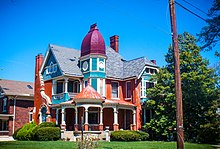About Norwood
Here’s a little bit about the city of Norwood if you are looking for a Tax Attorney Norwood Ohio.
Norwood is the second most populous city in Hamilton County, Ohio, United States, and an enclave of the larger city of Cincinnati. The population was 19,207 at the 2010 census. Originally settled as an early suburb of Cincinnati in the wooded countryside north of the city, the area is characterized by older homes and tree-lined streets.
The earliest humans in the area now known as Norwood are believed to have been Pre-Columbian era people of the Adena culture. Norwood Mound, a prehistoric earthwork mound built by the Adena, is located in Norwood and listed on the National Register of Historic Places. The Adena constructed the mound at the location of Norwood’s present-day Water Tower Park, which is the highest land elevation in the city and one of the highest in all of Hamilton County. Archaeologists believe the mound was built at this site due to the high elevation and was used by the Adena for religious ceremonies and smoke signaling.
Native American mounds are not uncommon in Ohio and several were located in Downtown Cincinnati at the time of arrival of the first white settlers. However, by 1895, the Norwood Mound was the only remaining mound in the vicinity of Cincinnati.” The mound has never been excavated, but it is reported that many artifacts found in the area by early Norwood settlers in the 1800s made up the original nucleus of the Native American Art Collection of the Cincinnati Art Museum. In the early-20th century, Norwood High School named their sports team mascot the Indians in honor of this local Native American heritage.
In 1787, the United States Congress established the Northwest Territory, and John Cleves Symmes, Congressman from New Jersey, purchased 311,682 acres (126,133 ha) of the territory (the Symmes Purchase), within which the future Norwood is located. One year later, the first permanent settlement on the banks of the Ohio River in what would later become Cincinnati was established. In 1793, General “Mad Anthony” Wayne led several companies of troops from Fort Washington in Cincinnati to advance against a hostile tribe of Native Americans encamped on the banks of the nearby Millcreek in what is now St. Bernard. Historians believe that a company of troops under the direction of General Wayne made their way through Norwood during this campaign and widened an old Native American trail, which followed the path of present-day Smith Road, Montgomery Road, and Carthage Avenue. In 1859, an early Norwood pioneer named Joseph G. Langdon claimed to have found a bullet buried in the heart of an oak tree on his Norwood property left by Anthony Wayne’s troops 66 years earlier.
In 1794, a pioneer named Peter Smith settled on Duck Creek in or near the current location of Norwood. It is believed he is one of the earliest Norwood settlers, if not the first. Soon after, a road was built connecting the early settlement of Columbia on the Ohio River near the Little Miami River with the settlement of Carthage, just north of Cincinnati. This road cut through Norwood along the old Indian Path widened by General Wayne’s troops (Smith Road, Montgomery Road, and Carthage Avenue). Anthony Wayne’s victory over the Indians at the Battle of Fallen Timbers the same year signaled the end of the Northwest Indian War which enabled pioneers to begin settling former hostile lands such as the future Norwood. In 1795, another road was built along the present-day path of Montgomery Road, connecting Cincinnati with Montgomery, Ohio and beyond. Montgomery Road was known as the “State Road” and Smith Road/Carthage Avenue was known as the “County Road.”
In 1809, a settler named Samuel D. Bowman purchased land near the crossing of the State Road and the County Road, where he established a tavern and coach stop for travelers. He was soon joined by John Sharp, who built a cabin and small country store at the opposite side of the intersection. The community of half a dozen houses soon became known as “Sharpsburg”, after Mr. Sharp. For the next half century, the little coach stop along the road between Cincinnati and Columbus didn’t create much of a stir in the world.
Norwood has a strong history of industry and manufacturing dating back to the historic Norwood Brick plant of the late 19th century, which provided clay brick for the construction of many of Cincinnati’s historic buildings. As the city is ideally situated between several major railways, state roads and interstate highways, it has traditionally been an attractive location for businesses and corporations in the area. Norwood was once described as the “Chicago of Hamilton County”, for in 1909 it had 49 manufacturing enterprises.
Prominent Norwood industrial and manufacturing companies included: General Motors Norwood Assembly, United Dairy Farmers, Allis-Chalmers, Siemens, Bullock Electric Manufacturing Company, United States Playing Card Company, Globe Wernicke, American Laundry Machine Company, Norwood Sash & Door Company (Sears Catalog Homes), United States Printing & Lithographing Company, U.S. Shoe Corp, Mead Container Corporation, J.H. Day Corporation, and Zumbiel Packaging.
Between 1923 and 1987, the General Motors automobile assembly plant was by far the city’s largest employer in terms of production, payroll and employees. When GM closed the factory in 1987, it nearly dealt a death blow to Norwood’s economy. This event became the catalyst for Norwood’s transition from an industrial economy to a diversified office and retail economy. In the years following the GM closure, Norwood worked with developers to build many mixed-use office parks and retail centers in the city, including: Grande Central Station (1990), Central Parke (1993), Rookwood Pavilion (1995), Rookwood Commons (2000), Cornerstone at Norwood (2004), Linden Pointe on the Lateral (2007), Surrey Square (2008), Rookwood Exchange (2014), Norwood State Station (2014).
The Norwood City School District consists of Norwood High School, Norwood Middle School, Sharpsburg Elementary, Norwood View Elementary, Williams Avenue Elementary, and Norwood Preschool. The current high school opened as a state-of-the-art facility in 1972, with a planetarium, greenhouse, swimming pool, and television studio. Drake Planetarium, named after astronomer and astrophysicist Frank Drake, is associated with NASA. Norwood High School’s mascot is the Indian. Norwood Middle School is located next to the high school in the previous high school building, which opened in 1914. In 1988, the Norwood Middle School field house and offices were used to film prison scenes in the 1989 Tom Selleck movie An Innocent Man. Norwood is also home to Immaculate Conception Academy parochial grade school and high school, located in the former Gressle School on Floral Avenue.
If you are looking for a tax attorney Norwood Ohio, you are at the right spot. Give us a call today at 330-331-7611.









